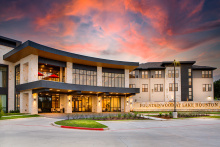
The senior living real estate sector has been navigating through a sea of challenges since the onset of the COVID-19 pandemic. However, recent data indicates a promising trend: senior living occupancy rates have been on the rise for eight consecutive quarters[1]. This article delves into the factors driving this recovery, the new metrics being used to measure growth, and the forecast for construction spending in the sector[2][3].
The Resilience of Occupancy Rates
Despite the challenges posed by the pandemic, senior living occupancy rates have been increasing steadily. The second quarter of 2023 marked the eighth consecutive quarter of growth[1]. This recovery can be attributed to strong demand for senior housing and a slowdown in inventory growth. However, occupancy rates are still below pre-pandemic levels, indicating that there’s room for further growth. For instance, the senior housing occupied stock is now 2.6% or 15,026 units above pre-pandemic levels[1].
Absorption-to-Inventory-Growth Ratio: A New Metric
To better understand the dynamics of the senior housing market, a new metric has been introduced: the Absorption-to-Inventory-Growth (AIG) ratio[2]. This ratio measures how effectively the market absorbs newly supplied units. In the second quarter of 2023, for every 10 new senior housing units added, there was a net absorption of 45 units, indicating strong demand[2].
Forecast for Construction Spending
The American Institute of Architects (AIA) forecasts an increase in construction spending in 2023[3]. This is good news for the senior housing sector, as increased construction spending could lead to more housing options for seniors. However, it’s important to note that the pace of construction will also depend on other factors, such as the economic climate and the availability of financing.
The Role of Technology
Technology is playing an increasingly important role in senior housing. From smart lighting controls to custom apps for resident convenience, tech integration is now a standard feature in senior living communities. Moreover, investing in technology can reduce perceived fixed costs and streamline operations, making it a crucial tool for efficiency in the face of staff shortages.
The Emergence of Affordable and Luxury Options
One of the most notable trends in senior housing real estate development is the increasing differentiation based on price point and service offerings. On one end of the spectrum, there’s a growing demand for affordable housing options for middle-income seniors, often referred to as the “Forgotten Middle.” On the other end, there’s a rise in “ultra-luxury retirement communities” offering high-end lifestyle living options[^5^].
Looking Ahead
While the recovery in senior living occupancy rates is a positive sign, the industry still faces several challenges. Rising expenses, labor shortages, and the ongoing effects of the pandemic are all factors that could impact future growth. However, the strong demand for senior housing, coupled with the expected increase in construction spending, provides a solid foundation for continued recovery.
In conclusion, the senior living industry has shown remarkable resilience in the face of adversity. The steady increase in occupancy rates, the introduction of new metrics to measure growth, and the positive forecast for construction spending all point to a sector that is poised for growth. As we move forward, it will be crucial for industry stakeholders to stay abreast of these trends and adapt their strategies accordingly.
